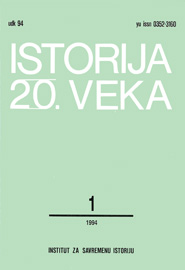BOSNA I HERCEGOVINA U RASPRAVAMA О DRŽAVNOM
UREĐENJU KRALJEVINE (SHS) JUGOSLAVIJE 1918 - 1941. GODINE
BOSNIA AND HERZEGOVINA IN DEBATES REGARDING STATE REFORM IN THE KINGDOM OF YUGOSLAVIA 1918 - 1941
Author(s): Mira RadojevićSubject(s): Geography, Regional studies, Political history, Recent History (1900 till today), Pre-WW I & WW I (1900 -1919), Interwar Period (1920 - 1939), WW II and following years (1940 - 1949), Geopolitics
Published by: Institut za savremenu istoriju, Beograd
Keywords: BiH; Kingdom of Yugoslavia; state reform debates; first half of 20th century; Serbs; Croats; Muslims;
Summary/Abstract: According to many contemporaries and latter-day historians, the most serious inner problem facing the Kingdom of Yugoslavia was the question of state reform. The issue of Bosnia and Herzegovina was a particularly controversial topic in these debates. The position of this province was directly subject to an agreement between the Serbs and Croatians, since the political inclinations of the Bosnian-Herzegovian Muslims could not have greater impact in the national status-quo of the first Yugoslav state. In their demands for a reform based on national principles and the creation of federal units, the Croatian political representatives offered several suggestions concerning Bosnia and Herzegovina. One of their proposals was that a greater part of the province should be given an autonomous or equal status in regard to the other federal units. The second suggestion was to divide Bosnia and Herzegovina between the Serbian and Croatian units and according to the third, founded on the idea of a dual Yugoslav state, the border would be on the Drina, while Bosnia and Herzegovina as a whole would become a part of the Croatian region. The majority of the Serbian political parties were against these solutions. Fearing a demarcation between the Serbs and the Croatians, the Democratic party proposed that Bosnia and Herzegovina with south Dalmatia become a fourth unit-the Serbian Croatian and Slovenian units being the other three. A part of the Serbian independent intellectuals supported this proposal. However, the Democrats themselves abandoned this proposal when Banovina Hrvatska was formed since it included 13 Bosnian-Herzegovian districts. From that time all Serbian political parties and organizations defended the view that Bosnia and Herzegovina was a Serbian province inhabited, towards the end of 1939, according to the Ministry Council statistics, by 1.226.991 (44.6%) orthodox Serbs, 858.140 (31.2%) Muslims, 595.974 (21.7%) catholic Croatians, 4.358 (0.1%) catholic Slovenians and 63.720 (2.3%) inhabitants of other nationalities and adherents of other religions. Contrarily, Croatian politicians demanded a further division of Bosnia and Herzegovina or the autonomy of the remaining part of this province. In this way the Croatians gave the impression of supporting the claims to independence of the Bosnian-Herzegovian Muslims.
Journal: Istorija 20. veka
- Issue Year: 1994
- Issue No: 1
- Page Range: 7-41
- Page Count: 35
- Language: Serbian

